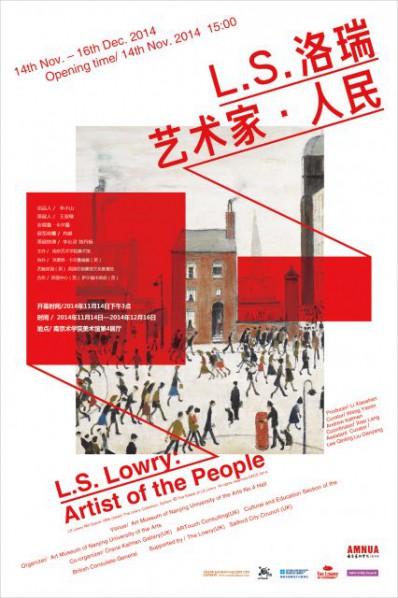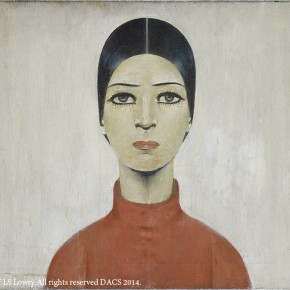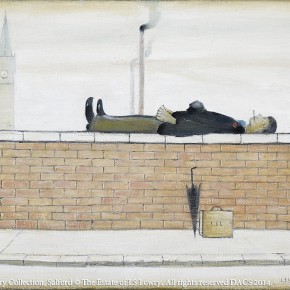
L.S.LOWRY (1887-1976) is one of the most important and famous British artists of the Twentieth Century, yet he is barely known in the rest of the world. Lowry has been the subject of more than 340 exhibitions from the early 1900’s to the present day yet "L. S. Lowry: Artist of the People", the show opening in November 2014 at the Art Museum of Nanjing University of the Arts is incredibly Lowry’s first ever museum exhibition overseas. With nearly thirty oil paintings and works on paper selected carefully from British public and private collections, this event in Nanjing is a very special occasion. Following the artists widely acclaimed retrospective exhibition at Tate Britain, London in 2013, the collection of works at AMNUA will enable a new public to explore and value Lowry’s art - in Nanjing, China and hopefully beyond. We are proud to present this exhibition, and its associated events, to the public at this moment.
L.S.Lowry began his career as an artist in the city of Manchester a hundred years ago. Manchester, in north-west England, had by this time come to represent an irreversible change in Britain. It was at the heart of the country's industrial growth and subsequent decline and the social changes that accompanied it. This city environment was of course full of people like Lowry; surrounded by factories, mills and chimneys (Mill Scene, 1965). This is why the idea of making a small Lowry retrospective in China resonated. China’s evolution from an economy rooted substantially in agriculture to one driven by the manufacture of products, quite often for export, mirrors changes Lowry observed and recorded in northern England nearly a century earlier.
Lowry was fascinated by human behaviour within this cityscape, from the image of a rain-soaked man shuffling to work (Man in a Trenchcoat, 1945) to the noisy clamour of an auction house sale thronging with people (The Auction, 1957). This was Lowry’s ‘food and drink’. This is Lowry, the artist of the people.
This concise exhibition of paintings and drawings will present a flavour of this hugely popular artist’s work to a new audience in China, who will hopefully empathize with the joys and dramas of living in a great bustling city, such as Nanjing.
Curators' StatementBy Wang Yamin
L. S. LOWRY (1887-1976) is one of the most important and famous British artists of the Twentieth Century, yet he is still an artist who is barely recognised outside the UK. With nearly thirty oil paintings and works on paper selected carefully from British public and private collections, L. S. Lowry: Artist of the People is Lowry’s first solo museum show outside the UK. Following his widely acclaimed retrospective exhibition at Tate Britain in 2013, the collection of works at AMNUA will enable a new public to explore and value Lowry’s art — in Nanjing, China and hopefully beyond. We are proud to present this exhibition, with its events, to the public at this moment.
For more than 50 years, Lowry painted the life and society that surrounded him, in Manchester in Northern Britain. Images of ordinary people at work and play, amongst the mills and factories, parks and football pitches of his home-town. These honest observations, sometimes with harsh imagery of the industrial landscape but other times full of wit and humour, are today enjoyed and admired by the general British public.
But controversies are always raised within the “Art World” and so to an acceptance of Lowry. One of the key questions is the core value of Lowry’s art, the close relationship between art and the people. All of the sturdy things are vanished, all of the holy things are profaned; this declaration of Marx about Modernity by the approach of socialism plutonomy was also echoed in the Modern Art revolution since 19th century with its stress on the relationship between art and the people. But at the same time, the presence of the people in art was also often bleached. With Modernism, one of the key practices of contemporary art is the Political practice as Aesthetics practice; morality question is just aesthetic question. How art can serve the people becomes one of the knots in artists’ minds.
The main context of Lowry’s art was modern life against the backdrop of the British Industrial Revolution and its gradual decline. He was renowned for his industrial landscapes of the “Cotton Capital”, Manchester, with the everyday grassroots of life, witnessed in the streets and lanes of the city. Such depictions of contemporary life could exude an atmosphere of frustration and loneliness but with dignity and humour. We can see how the people bear the dilemma brought about by modern life: the deterioration of the living environment and the estrangement of people from society. In this sense, we would like to call Lowry’s art a kind of “heroism” among modernity (Baudelaire). Such heroism was particularly represented by Lowry personally. Lowry’s life and art practices were tied closely with common peoples. Insisting on being an artist of the people, Lowry showed us how a painter survived and even thrived. Lowry declared all his paintings were “self-portraits” — to respect the people is to respect the humankind (Goncourt).
Because the historical process of China with its reality of the moment, the social problems caused by the development, cornered dwelling of people, etc., this exhibition in Nanjing will provoke resonance and reflection. An artist as one of the people, how the people occupy ART, etc., all of these are also present important art proposition-for many fashionable contemporary art practices (Participation, Intervention and Public, etc.), the fineness of the people reflected in art is really a touchstone.
By Andrew Kalman
Laurence Stephen Lowry (1887-1976) (commonly known as L.S.Lowry) was born in Manchester in northern England in 1887 and went on to become one of the UK's most famous, successful and popular artists. His paintings and drawings recorded the changing sights, scenery and behaviour of British society, as it hurtled through the C.20th, all the way through to his death in 1976, aged 89.
Before and during the Second World War, Lowry’s subject-matter illustrated the hardships and strife of post-industrial (northern) Britain; existential images that mirrored the artist’s own frustrations, working during the day as a rent collector, painting at night, while also caring for his ailing parents. His works painted in a darker palette and with a thicker, more heavily layered paint surface, emphasize the travails of many of the artist’s fellow citizens. This is after all a society still coming to terms with near bankruptcy following the end of the First World War: a nascent but not fully enfranchised and restless Labour Movement; a fading Empire; and an embryonic ‘financial system’ that had just experienced a calamitous collapse, wreaking devastating economic instability and panic. This too is a country without the safety net of an NHS or welfare – a class-ridden society, unsure whether it had truly emerged from nineteenth-century Victorian Britain.
Lowry, although not in a parasitic way – far from it in fact, he was quite altruistic – thrived on such desperation, or at least his body of work did. Much of his painted imagery took place in the glare of the public gaze: witnessed by many but recorded by only one – Lowry. The clamour and commotion of a fight, an accident, an arrest or such like, drew a crowd of onlookers who cared to take notice, just as a normal, soot-saturated Manchester day was chatted about and perhaps then quickly ignored. Pre-war and in the early 1940s, this was Lowry’s visual palette – one he committed to canvas with the honesty of a documentary cameraman: a genuine social historian.
After 1945, changes in society occurred with greater pace and so too did the artist’s work: retired from office job, his parents deceased, buoyed by art market success and growing popular acclaim, Lowry was rejuvenated. Although still forgoing many accoutrements of postwar ‘modernity’ – television, the telephone, a motor car (Lowry preferred to take taxis to his favourite destinations, a bit like me) – the ageing painter adopted a lighter feel, a brighter, broader range of colours, gaiety even. He still painted great and complex scenes of public record, but these were joyous, jubilant pictures, anticipating the nation’s increasingly expectant hope for a more stable, healthier and wealthier future.
My late father Andras Kalman (1919 - 2007), a Hungarian Jewish refugee arrived to the UK in 1939, aged 20. He opened his first gallery in Manchester 10 years later. Lowry visited in 1950 and became a client, acquiring paintings by French artists from my fathers struggling business. Despite their many differences - age, nationality, background, behaviour and even height, they forged a close friendship.
My father moved his gallery to its current location in Knightsbridge, London in 1957, and although never Lowry's primary dealer, over many years sold 100's of works by the artist. The Gallery also made interesting and varied Lowry exhibitions and catalogues, all the while agitating for British art institutions to promote Lowry's work overseas but unfortunately this never happened, either during the lifetime of Lowry or my fathers.
This is why I am so pleased and proud to have assisted in the realisation of this small but special exhibition of Lowry's work at the Art Museum of Nanjing University of the Arts - the artists first ever Museum exhibition outside of the UK. So thank you to all at AMNUA, particularly Professor Li Xiaoshan, Wang Yamin and also Burberry Asia Ltd., Willis and AXA insurance companies for their support and most of all to Xiao Lang, the freelance, representative of the AMNUA in London, whom I met at the Masterpiece Fair in London in 2013, and whose infectious enthusiasm and encouragement sparked the exhibition into life.
About the exhibition
AMNUA: Exhibition 14 November – 16 December 2014
Organiser: Art Museum of Nanjing University of the Arts, China
Co-organiser: Crane Kalman Gallery (UK), ARTouch Consulting (UK), Cultural and Education Section of the British Consulate-General (China)
Supporter: The Lowry (UK), Salford City Council (UK)
Sponsor: Willis (Global Insurance Broker and Risk Adviser), AXA
Producer: Li Xiaoshan
Curator: Wang Yamin, Andrew Kalman
Coordinator: Xiao Lang
Assistance Curator: Li Qingling, Liu Danyang
Courtesy of the artist and the organisers.


































